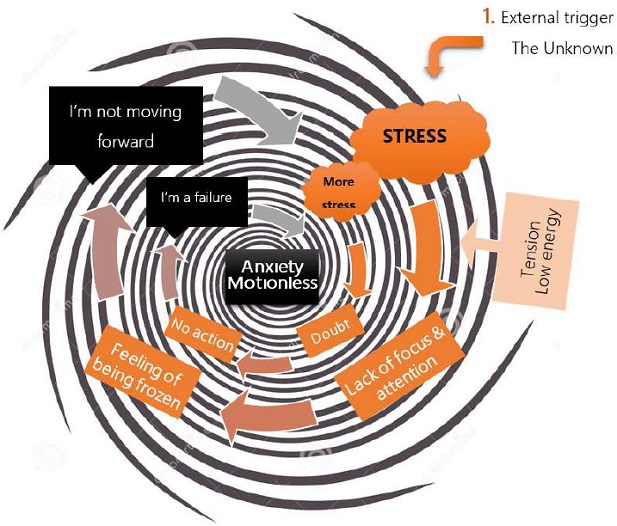 Let’s take a moment here, where you can consider the last time you felt anxious?
Let’s take a moment here, where you can consider the last time you felt anxious?
What was it about? What was the underlying trigger?
What are the thoughts, emotions and behaviors that happened before the anxiety started to be unpleasant?
Better understanding what triggers anxiety for us and at what moment the positive stress becomes an obstacle will help us realize upfront where we are heading and take action before we are completely motionless.
As if we would be able to identify the moment before we start to look like the man in the anxiety picture above, when we start to retract internally, close our eyes and let our thoughts sit like elephants on our head.
Shifting from anxiety to excitement
Now that you start to be able to observe the impact of your anxiety on your emotions and behaviors and you are more aware of your triggers, what about asking yourself:
What do you find exciting about this unknown situation?
How would you feel to say out loud: “I am excited about this….”
Then observe your body and your thoughts. What is changing? How is it changing?
Can you visualize yourself in the unknown as being excited?
Think then what action you can take to move towards this task, outcome? Immediately, but also in the coming days? How can you use this image of being excited to generate ideas and to hold yourself accountable?
Reflection
As pointed out by Alison Wood Brooks, her work was one of the first to explore “how a self-statement of emotion may influence one’s own experience of emotion and subsequent behavior. The current findings demonstrate that, before anxiety inducing tasks, the way we talk about our feelings influences whether we feel anxious or excited, which dramatically influences subsequent performance.”
After experimenting yourself, what do you think about that statement?
How would you link it to the idiom: “fake it until you make it?”
Coaching application
Clients come to coaching in order to get some support to move forward towards a desired outcome. In that sense, anxiety (at least in its light form) will eventually pop up in the coaching journey. Coaching is all about a journey through change – self-awareness, change of perspective, change of beliefs, change of behaviors, change of job, change of mindset, change, change, change. When a change is happening, at one point it means to be able to let go a current state in order to embrace a new vision or practice. In the process, this will raise uncertainties: as the client starts to define better their desired state, they will also realize how the current state (be it in behaviors, believes, reactions, job, financial situation…) is not aligned anymore. However, the current state has one key characteristic that will often take the client in hostage: the certainty (of what they have). As much as the current state is not desired anymore, the mere fact to let go of something does create a sense of insecurity and uncertainty. And most probably some range of anxiety and discomfort will make its way to the client’s head limiting his/her capabilities to move forward.
There are hence many different opportunities within the coaching relationship to get this power tool out of the drawer.
How to move the client away from the anxiety circle into a positive – excitement – energized circle?
Real example
A peer-client is facing some anxiety to start to coach: will my question be powerful enough, will I be able to listen and build on what the client is talking, will I have an impact, will the client come out of the session with a valuable outcome, etc. the list could go on… In this case, the anxiety was based on the uncertainty this new way of acting triggers. The client does not know yet how the outcome will be, so he/she must learn to trust the process itself.
By asking questions like,
You facilitate the client to envision another perspective to look at uncertainty: a perspective that is based on excitement and enthusiasm that will empower him/her to let go of the fear but also to find ideas & solutions that will allow him to move into action.
By moving from anxiety to excitement, the full body-energy was changing, the tone of voice became lighter, the head started to lift again, shoulders came back, a smile appeared on the face. With that physical change, the thoughts followed by being more positive, driven towards action and new ideas kept coming in linked to the client’s vision about herself and what kind of coach she wanted to be.
By acknowledging the change that this client just experienced, it helped her understand how she can herself hold these two perspectives in her head. She shared with me this powerful image; it was as if she had in front of her two bubbles:
And she was the one to decide which one she wants to choose and how this choice impacted her actions, feelings and thoughts.